
Diselma archeri is a species of plant of the family Cupressaceae and the sole species in the genus Diselma. It is endemic to the alpine regions of Tasmania's southwest and Central Highlands, on the western coast ranges and Lake St. Clair. It is a monotypic genus restricted to high altitude rainforest and moist alpine heathland. Its distribution mirrors very closely that of other endemic Tasmanian conifers Microcachrys tetragona and Pherosphaera hookeriana.

Gaultheria hispida, commonly known as the copperleaf snowberry, is an endemic eudicot of Tasmania, Australia. It is an erect multi-branched shrub, that can be found in wet forests and alpine woodlands. Its berries appear snowy white and leaves are tipped with a copper tinge, hence the common name.

Geranium potentilloides, belongs to the family Geraniaceae, and is a small prostrate perennial herb that can grow up to 60cm high. The species is commonly referred to as Soft Cranesbill or Cinquefoil geranium.

Pittosporum bicolor, commonly known as cheesewood or banyalla, is a flowering shrub or small tree of the family Pittosporaceae, and is native to south eastern Australia.

Pentachondra pumila, also known as carpet heath, is a small alpine shrub in the epacris family (Ericaceae).. It is commonly found in Australia and New Zealand in areas of high rainfall, being known for its small white flowers as well as its red, hollow fruit that grows on branch ends. It is distinguishable as a prostrate, mat-like shrub, growing in rocky or boggy alpine areas. The fruit is edible and is a food source for many species of bird.

Agastachys odorata, commonly known as the white waratah or fragrant candlebush, is the sole member of the genus Agastachys in the protea family. It is an evergreen shrub to small tree and is endemic to the heaths and button grass sedgelands of western Tasmania.

Monotoca scoparia, commonly known as prickly broom heath, is a widespread native species across south-eastern Australia. Monotoca scoparia was formerly in the family Epacridaceae but now belongs to the family Ericaceae. Monotoca is an endemic Australian genus with 17 described species occurring in all states.

Campynema is a genus in the family Campynemataceae first described in 1805. It contains only one known species (monotypic), Campynema lineare, endemic to the island of Tasmania in Australia. Its closest relative is Campynemanthe, endemic to New Caledonia, sole other genus of the family.
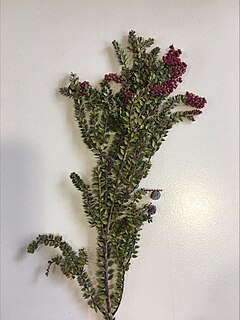
Trochocarpa thymifolia is a species of flowering plant from the family Ericacae and is endemic to Tasmania. It is a widespread alpine and subalpine shrub with small leaves, pink to red flowers and blue to purple fruit. Originally described by botanist Robert Brown in 1810, it is a widespread Tasmanian endemic that inhabits the state's mountain regions.
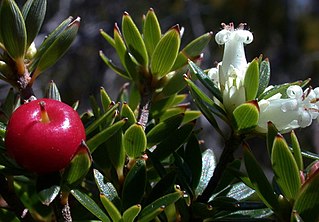
Cyathodes straminea, also known as false-whorled cheeseberry, is a species of flowering plant in the family Ericaceae endemic to Tasmania, where it grows as an alpine to subalpine shrub with a spreading habit. The generic name Cyathodes was derived from Greek "Cyath" = cup and "odes" = like, referring to the ovary encircled by cup-shaped nectary.
Monotoca glauca, known as goldy wood, is a heath family shrub endemic to Tasmania, Australia and is one of 17 described Monotoca species. It is a widespread and abundant understory species found on the margins of wet eucalypt forests and logged areas.
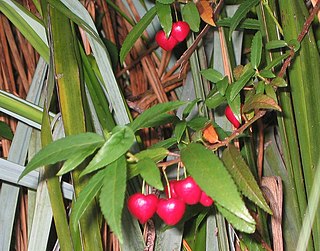
Aristotelia peduncularis, also known as heartberry, is a shrub in the family Elaeocarpaceae, endemic to the wet forests of Tasmania

Trochocarpa cunninghamii is a flowering plant species of the family Ericaceae. It is commonly referred to as straggling purpleberry due to its round flattened mauve drupe fruits. This woody shrub is usually found in the understorey of rainforests and subalpine forests in the Central Plateau and western Tasmania, and is endemic to Tasmania.
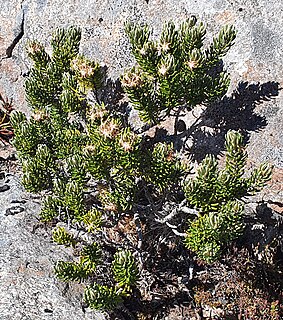
Olearia ledifolia, commonly known as rock daisy bush, is a species of flowering plant of the family Asteraceae. It is endemic to Tasmania and found at higher altitudes where it grows as a low, compact bush with tough, leathery leaves and small white and yellow daisy-like "flowers" in summer.
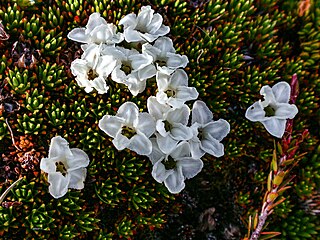
Dracophyllum minimum, commonly known as heath cushionplant or claspleaf heath, is a species of bolster cushion plant endemic to Tasmania, Australia. It is a low growing, highly compacted plant with white flowers, commonly found in alpine areas of the south, centre and west of Tasmania.

Coprosma moorei, commonly known as blue matcurrant or turquoise coprosma, is a small, mat forming, prostrate shrub in the Rubiaceae family. It is native to highland areas of Tasmania and Eastern Victoria.

Leptecophylla parvifolia, commonly known as the mountain pinkberry, is a small to medium sized shrub within the Ericaceae family and is endemic to the highlands of Tasmania. This species was first collected and documented in 1804 by Robert Brown and was formerly included in the Cythodes genus. It was then as noted as subspecies of Leptecophylla junipernia but in 2018, was classified as its own species

Monotoca submutica, commonly known as mountain broomheath, is an endemic heath family shrub in the Epacridaceae family and is one of 17 species in the genus Monotoca. It is a widespread and locally common small to tall woody dense shrub found in the alpine/subalpine woodlands of southern and western mountains of Tasmania, Australia.

Anemone crassifolia, commonly known as mountain anemone, is a perennial herb in the family Ranunculaceae and is endemic to Tasmania, Australia. The species is common in high alpine moorlands of western and southern Tasmania at approximately 1000m. It is the only representative of the genus Anemone found in Australia.
Celmisia saxifraga, commonly known as the small snowdaisy, is a perennial herb in the Asteraceae family. It is native to Tasmania and Victoria, where it grows in alpine grasslands above the snowline.


















